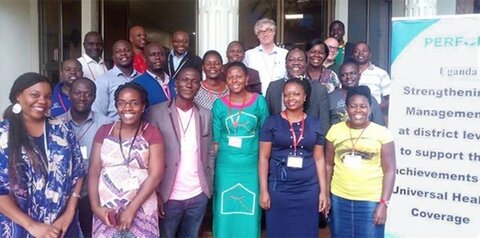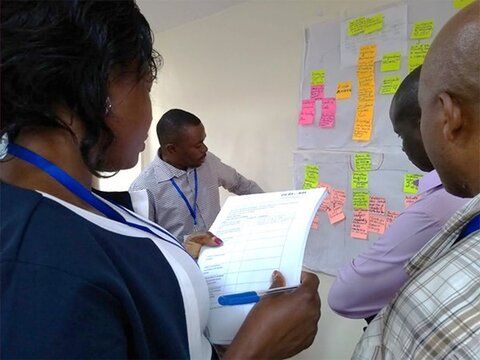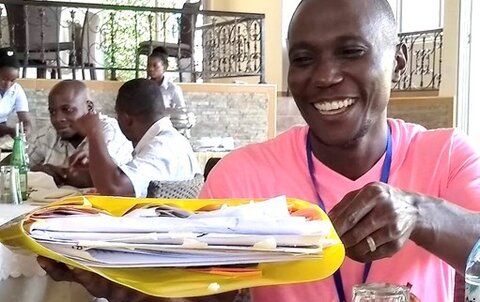Building management capacity at district level to improve workforce performance
The three neighbouring districts, Luwero, Wakiso and Nakaseke, have been selected to participate in PERFORM2Scale’s first management strengthening initiative to improve health workforce performance in Uganda. The important stages of problem analysis and the development of strategies to address priority problems took place during two short workshops in Mukono and Wakiso districts, near the capital Kampala.
Workshop one – selecting problems

The first workshop followed a period of orientation and support visits for the District Health Management Teams (DHMT) during which they collected basic information to support a situation analysis. Eighteen (18) DHMT members from the three districts arrived for the first 1.5 day workshop starting 28th June. They started by making presentations based on their situation analyses and listed their priority problems. The teams quickly moved on to select problems to work on. They were advised to select manageable problems within the current resources of the district. Two districts independently selected staff absenteeism – the ultimate cause of poor staff performance – and a third chose a problem related to sub-optimal performance of TB services, but which included workforce performance causes.
Peer review is an important part of the workshop process, so after each presentation DHMT members from other districts gave feedback and sometimes suggestions for improvement. For example, the magnitude of absenteeism in both Wakiso and Nakaseke districts was not evident and they were advised to to collect evidence about absenteeism from within their systems such as the support supervision reports, DHMT meeting minutes and community text reports blasted through Mtrac 8200. Having developed a simple problem statement, the DHMTs then worked in their teams to analyse the causes of their problems using post-it notes to create a ‘problem tree’ which allow for easy revision and lots of debate.
Once the first draft of the problem analysis had been developed, peer review was carried out in the form of a ‘gallery walk’ to review the problem trees. The teams just have time to make minor revisions to their problem trees based on the feedback before the end of the workshop. They were advised to go back to their duty stations to refine the analysis of their selected problems.
Workshop two – strategy development

In the month before the second workshops in August, the participants shared their work with other DHMT members who did not attend the first workshop and make some refinements to their problem analyses. In fact, Luwero DHMT, after consultation with the TB expert in their team, after intensive analysis and consultations changed their problem statement from: sub-optimal laboratory performance in TB to ‘improve cure rate for TB’. This was a chance to collect more data on the problem, too.
One DHMT did a one-day mini survey and found that in two facilities more than 30% of the staff were absent. Another analysed the complaints texted by users via the Health Service Anonymous Hotline on Mtrac 8200 and found that since 2015 more than 50% of the complaints had been about staff absence.
The second workshop (2.5 day from 1st August) was attended by most of the same participants as the first. Time was provided to further refine the problem analyses to ensure that they were ready to work on to develop strategies, though this caused at least one participant to become a bit frustrated: “we may even end up where we started”. Before starting the work of developing relevant strategies, an introductory presentation was given to help participants analyse the relevant areas of workforce performance, e.g. direction, competencies, rewards and sanctions, or other relevant health system areas like equipment or information systems. The teams then, using more post-it notes, developed an ‘objectives tree’ to complement their ‘problem tree’.

Again, during the peer review process the ‘objective trees’ were revised and transferred to a workplan format, which some DHMTs then began to consider how these problem-focussed plans could be integrated into their district plans. The workshop finished with planning the next steps, including discussing how some sort of diary could be used to help the DHMTs with the all-important action research component of reflection.
One participant said, “at the beginning I didn’t really know where we were going, but I couldn’t say so as I’m the focal person” – but after the two workshops things were much clearer.
The teams worked long hours to get as far as they did and were justifiably proud of their achievements. Although one team had captured the whole plan on their computers, they still wanted to take the post-it note version home with them!
Check out some Twitter moments from the two workshops